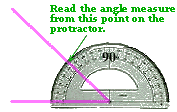|

Dictionary
A
B
C
D
E
F
G
H
I
J
K
L
M
N
O
P
Q
R
S
T
U
V
W
X
Y
Z
- palindrome
- Words, numbers and phrases that can be read the same backwords as forwards. Some examples include: "mom", "racecar", "34543", or the phrase "never odd or even".
- paradox
- A statement that appears to contradict itself, for example, suggesting a solution which is actually impossible (cfTortoise and Hare Race).
- parallel
- Lines that are in the same
plane that do not intersect (cfRectangles Discussion).
- parallelogram
- A quadrilateral
that contains two pairs of parallel sides (cfParallelograms Discussion, Rectangle Discussion).
- pattern
- Characteristic(s) observed in one item that may be repeated in similar or identical manners in other items.
- percent
- A ratio that compares a
number to one hundred. The symbol for percent is % (cf
Percents Discussion).
- perimeter
- The sum of the lengths of
all the sides of a polygon. (cfLength, Area, and Perimeter Lesson).
- permutation
- A a particular ordering
of a set of objects. For example, given the set {1, 2, 3}, there are six
permutations: {1, 2, 3}, {1, 3, 2}, {2, 1, 3}, {2, 3, 1}, {3, 1, 2}, and
{3, 2, 1}.
- personal view
- An approach taken
by mathematicians and philosophers to calculate probability.
Using their knowledge and reasoning skills, they think through the problem.
See theories of probability (cf
Probability vs. Statistics Discussion).
- Pi
- The designated name for the ratio of the circumference of a circle to its diameter.
- pie graph
- A diagram showing a system of connections or interrelations between two or more things
by using a circle divided into segments that look like pieces of pie.
- polygon
- A closed plane figure formed
by three or more line segments (cf
What Are Tessellations
Discussion).
- polyhedra
- Any solid figure having many faces (cf Polyhedra Discussion).
- prime number
- A number that has exactly
two factors, 1 and the number itself (cf
Venn Diagrams Discussion).
- prisoners
- values for c in the Julia Set or Mandelbrot set where at each iteration
the resulting value becomes smaller and smaller, approaching zero (cf Prisoners and Escapees -- Julia Sets Discussion).
- probability
- The measure of how likely it is for an event to occur. The probability of an event is
always a number between zero and 100%. The meaning
(interpretation) of probability is the subject of theories of probability. However,
any rule for assigning probabilities to events has to satisfy the axioms of probability.
- protractor

An instrument for laying down and measuring angles on paper, used in drawing and
plotting (cf From Geometry to Probability Discussion).
- Pythagorean theorem
- A theorem in geometry that states given a right triangle, the sum of the squares of the lengths of the legs
is equal to the square of the length of the hypotenuse. This is often represented by the equation
a2 + b2 = c2, where a and b are the length of the legs and c is the length of the
hypotenuse.
A
B
C
D
E
F
G
H
I
J
K
L
M
N
O
P
Q
R
S
T
U
V
W
X
Y
Z

Please direct questions and comments about this project to Addison-Wesley
math@aw.com
© Copyright 1997-2001
The Shodor Education Foundation, Inc.
© Copyright 2001 Addison-Wesley. All rights reserved.
|